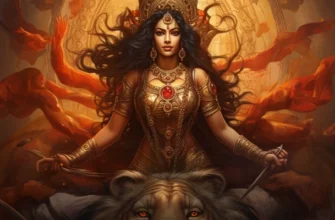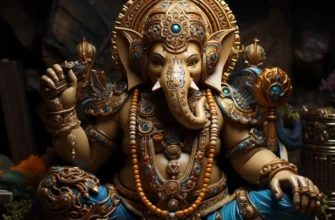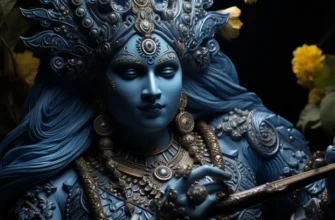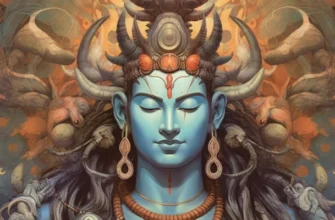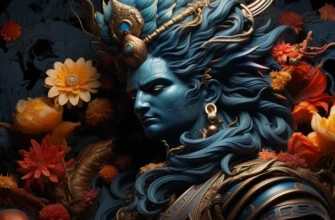Lakshmi is an Indian goddess of wealth, prosperity, success and beauty who is admired and revered in Hinduism. She is depicted as a woman with four arms that symbolize values such as kindness, power, success and generosity. Belief in Lakshmi plays an important role in Indian culture and society, acting as a symbol of prosperity and well-being. Her festivals and rituals are important components of Indian tradition.Foreword to Lakshmi
The cult of the goddess Lakshmi is of great importance in Indian Hinduism, as she is considered the embodiment of prosperity, wealth and well-being. She is revered and worshipped in the desire to achieve financial stability, success, and prosperity. The cult of Lakshmi encourages people to believe in the generosity of the universe and the importance of showing kindness and generosity in their lives. It is a practice that contributes to the spiritual and material development of the individual, as well as promotes harmony and well-being in society.
- Mythological significance
- The origin of Lakshmi in Indian mythology
- Legends and stories associated with the goddess Lakshmi
- Here are some specific legends associated with the goddess Lakshmi:
- Lakshmi’s role in the pantheon of Indian gods and goddesses
- The cult of Lakshmi today
- Modern rituals associated with the worship of the goddess Lakshmi include:
- Popular festivals honoring the goddess Lakshmi
- Belief in Lakshmi and its impact on contemporary Indian society
- Lakshmi in art and culture
- Visual representation of Lakshmi in Indian art
- Lakshmi’s influence on Indian literature, painting and sculpture
- Popular works honoring the goddess Lakshmi
- Conclusion
Mythological significance
Lakshmi has a deep symbolic meaning in mythology. Her origin is associated with legends that tell of her emergence during the cosmic struggle between gods and demons for the nectar of immortality. Lakshmi is a symbol of spiritual and material well-being, generosity and kindness. Her presence in mythology emphasizes the importance of harmony and balance in the universe, and emphasizes the importance of generosity and good deeds as a path to spiritual and material prosperity.
The origin of Lakshmi in Indian mythology
In Indian mythology, the origin of the goddess Lakshmi is associated with the myths of the god Vishnu. According to the legend, Lakshmi appeared during his meditation on Mount Mandarachali during the struggle between gods and demons for the nectar of immortality (amrita). She acted as his companion and the embodiment of inner beauty and goodness. In another version of the myth, Lakshmi appears during a search for a god who invokes her as an embodiment of beauty and goodness that helps in the fight against evil and injustice. This origin emphasizes her significance as a symbol of well-being, prosperity, and moral purity.
Legends and stories associated with the goddess Lakshmi
Many legends and stories are associated with the goddess Lakshmi. One of them tells of her coming to Earth to save humanity from suffering and hardship by granting generosity and wealth. Another legend connects her with the emergence of Samudra Manthan, when gods and demons united to bring out the nectar of immortality from the sea, and Lakshmi appeared during this event. Her stories and legends demonstrate her role as a protector, generous giver, and source of goodness and prosperity.
Here are some specific legends associated with the goddess Lakshmi:
The legend of Lakshmi’s appearance during the Samudra Manthan (or “Amrita Manthan”): According to this legend, during the struggle between the gods and demons for the nectar of immortality, Lakshmi appeared from the Mandarachali mountain, which was used as a steering wheel during the forced cooperation of both sides.
The legend of Lakshmi and Vishnu: There is a legend of how Lakshmi came into being during the meditation of the god Vishnu on the island of Xirotana to help him in his mission of saving the world.
The legend of Lakshmi and Bali: This legend is related to the struggle between the god Vamana and the demon Bali, where Lakshmi shows her loyalty to the good god by acting as his patron and assistant in his plans.
These legends collectively emphasize the importance of Lakshmi as a symbol of well-being, wealth, generosity, and blessing.
Lakshmi’s role in the pantheon of Indian gods and goddesses
In the pantheon of Indian gods and goddesses, Lakshmi plays an important role as the goddess of wealth, well-being and prosperity. She is considered the patroness of material well-being and financial stability. Lakshmi also promotes harmony, peace, and generosity among other gods and goddesses, and is often depicted in their company, demonstrating her majesty and power. Her presence in the pantheon emphasizes the importance of material and spiritual well-being in Indian culture.
The cult of Lakshmi today
Today, the cult of Lakshmi is an important part of Indian culture and society. She is revered and worshipped in festivals that celebrate her blessings and generosity. Modern rituals associated with Lakshmi worship include prayers, special rites and rituals aimed at attracting her blessings and support. Belief in Lakshmi remains an important element of contemporary Indian society, investing hope and faith in the well-being and prosperity of future generations.
Modern rituals associated with the worship of the goddess Lakshmi include:
Gifts and sacrifices: Believers bring gifts and sacrifices to the goddess, such as flowers, fruits, sweets, money, and gold, as symbols of wealth and generosity.
Prayers and mantras: Believers repeat prayers and mantras dedicated to Lakshmi to appeal to her and promote her blessings.
Performing rituals during festivals: Festivals, such as Diwali (Festival of Lights), include rituals and ceremonies associated with Lakshmi, including setting up lamps, candles, and decorating the home to attract her presence.
Special powders and symbols on the doorstep: Special symbols and designs are often painted on the doorstep of the house with powder to symbolize Lakshmi’s arrival and ensure blessings.
Making donations: Believers perform donations and charity to express gratitude for Lakshmi’s generosity and help to others.
These rituals are performed with the belief that worshipping Lakshmi will bring wealth, prosperity, and well-being to the lives of the faithful.
Popular festivals honoring the goddess Lakshmi
Two of the most popular festivals that honor Goddess Lakshmi are Diwali and Varalakshmi Gate.
Diwali (Festival of Light): This is one of the most important and largest festivals in India, celebrated with light, joy, and generosity. It is associated with the arrival of Lakshmi, and believers decorate their homes with lamps and candles to attract her blessings.
Varalakshmi Gate: This is an annual ritual where women honor Lakshmi by glorifying her as the patroness of wealth and prosperity. Women organize special rituals, offering fruits, flowers and sweets to the goddess, and pray for her blessings and protection.
These festivals are not only religious holidays, but also a time of joy, family harmony, and joint celebration for Indian families.
Belief in Lakshmi and its impact on contemporary Indian society
Belief in the goddess Lakshmi remains an important element of contemporary Indian society. It influences people’s mentality and values, emphasizing the importance of generosity, kindness, hard work, and financial stability. Belief in Lakshmi encourages people to do good deeds, give to charity, and work on self-improvement. Her cult contributes to the preservation of traditions and cultural values, and strengthens the perception of blessings and prosperity as an important element in Indian life.
Lakshmi in art and culture
Lakshmi plays an important role in Indian art and culture, manifested in various forms of visual art, literature, and music. She is often depicted in patterns, painting masterpieces, sculptures, and various art forms as a symbol of wealth, beauty, and generosity. Her image and symbolism are often used in various works of Indian literature, from epic poems to contemporary literary works, reflecting her important place in Indian culture and society.
Visual representation of Lakshmi in Indian art
In visual art, Lakshmi is often depicted as a woman with four arms holding various symbols of wealth, power, and generosity, such as lotus, grain, gold, and water. She is usually dressed in a multi-layered outfit that emphasizes her majesty and importance. Her image may also be accompanied by images of an elephant or water, which are attributes of her strength and fertility. These visual representations of Lakshmi reflect her symbolic significance as the goddess of wealth, beauty and generosity in Indian art.
Lakshmi’s influence on Indian literature, painting and sculpture
The goddess Lakshmi has a significant influence on Indian literature, painting and sculpture. In literature, she is often mentioned as a symbol of wealth, prosperity, and generosity, as well as a source of inspiration for poetic imagery and metaphors. In painting and sculpture, her image serves as an example of beauty, grace, and blessing. Her images can be found in temples, buildings, and museums as an embodiment of the grandeur and richness of Indian culture. Lakshmi’s influence can be traced back through the ages, adding richness and beauty to Indian art and literature.
Popular works honoring the goddess Lakshmi
Some popular works honoring the goddess Lakshmi:
Sri Sukta: This is one of the most famous poems dedicated to Lakshmi, which contains prayers and praises to the goddess for her generosity, blessings, and favors.
“Lakshmi Stotram: This is a collection of poems and prayers that praise Goddess Lakshmi and glorify her generosity, kindness, and blessings.
“Lakshmi Astakam: This is a poetry collection of eight poems that address Lakshmi, praising her greatness and blessings.
These works are important components of Indian spirituality and literature, reflecting the importance of Lakshmi as a symbol of wealth, beauty, and generosity.
Conclusion
Lakshmi’s legacy in the modern world is reflected in the continuing belief in generosity, blessings, and material prosperity. Her cult remains an important element of Indian culture and society, encouraging people to do good deeds, charity and hard work. Her image and symbolism are preserved in Indian art, literature and religious traditions, emphasizing the importance of understanding the balance between material and spiritual well-being in the modern world.
Lakshmi remains an important figure in Indian society and beyond. Her cult plays a large role in contemporary Indian culture, encouraging the development of values such as generosity, blessings and well-being. Lakshmi serves as a symbol of wealth and financial prosperity, which has an important influence on the economy and consumption in India. She is also important for Indian festivals and rituals, which helps to maintain and strengthen cultural traditions. Outside of India, belief in Lakshmi influences the Indian diaspora and is practiced in various countries.

